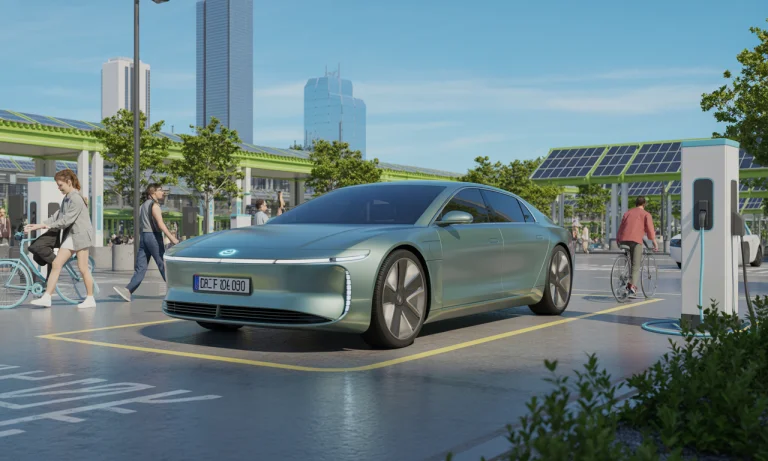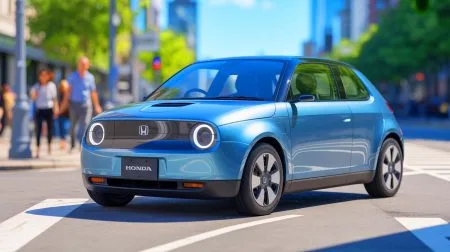Aboard the morning hustle of an Indian metropolis, the blue-liveried bus glided through traffic, silent except for the hum of fans and relieved chatter from passengers. Few noticed the discreet H2 logo near its door. Beyond this one bus, the world is searching feverishly for solutions: choking pollution, energy security anxieties, and a climate barrelling toward crisis. The road ahead has long seemed mapped for battery-electric vehicles, yet rising out of the fog, hydrogen-powered cars—the fuel cell vehicles of both science fiction lore and real engineering muscle—now attract newfound attention. In 2025, headlines bounce between prototypes and political ambitions, from BMW’s iX5 Hydrogen prowling European highways to India’s first hydrogen buses rolling through Delhi. Could this gas—evanescent, ancient, but only recently tamed—steer transportation into a new epoch? Beneath hopeful headlines are tough questions: cost, infrastructure, water scarcity, and the will to break age-old patterns. Yet for the first time, hydrogen’s story may be more than just a promise on the horizon.
Hydrogen Cars vs. Electric Cars: Changing the Future of Mobility
Hydrogen-powered vehicles occupy a unique crossroads in the evolution of modern transportation, beckoning the world with the allure of zero tailpipe emissions and the possibility of swift refueling. Unlike battery-electric cars, hydrogen-powered cars like those designed by Toyota, Hyundai, Honda, and BMW sidestep the long charging hours that can frustrate motorists. Instead, their appeal centers on the remarkable union of clean mobility and driving convenience—essential for both long-haul truckers and families seeking practicality. The appeal is strongest in applications where BEVs struggle: heavy loads, demanding routes, or climates hostile to lithium batteries.
Yet the reality on the ground tells a subtler tale. Selling hydrogen cars at scale remains a challenge, with pioneers such as Mercedes-Benz and Audi pivoting between battery and hydrogen strategies, while brands like Nikola and Riversimple carve niche reputations around distinctive fuel cell models. As of recent years, hydrogen’s largest hurdles remain infrastructure and price—a stubborn “chicken-and-egg” dilemma. Even as India invites global attention with its National Green Hydrogen Mission, skepticism persists. Can ambitious pilots and industrial partnerships convert novelty into a mainstream revolution?
| Brand | Flagship Hydrogen Model | Range (miles) | Refueling Time (minutes) | Primary Market |
|---|---|---|---|---|
| Toyota | Mirai | 402 | ~5 | USA, Japan, Europe |
| Hyundai | Nexo | 354-380 | ~5 | Korea, Europe |
| Honda | CR-V FCEV | Est. 300+ | Unknown | USA, Japan |
| BMW | iX5 Hydrogen | 313 | 3-4 | Europe, Pilot |
| Riversimple | Rasa | 300 | Unknown | UK |
| Mercedes-Benz | GLC F-CELL (pilot) | 271 | ~3 | Europe |
| Audi | h-tron Quattro (concept) | 370 | 4 | Europe (concept) |
| Nikola | Tre FCEV Truck | 500+ | ~20 (truck) | North America |
| General Motors | Hydrotec (truck/bus) | 400+ | ~15 | USA |
| Renault | Master Van H2-TECH | 250 | ~5 | France |
Hydrogen Production: Greening the Source for Clean Cars
Hydrogen itself may be colorless, but debate about its origins is anything but. The vast majority of the hydrogen fueling vehicles on roads today comes from fossil fuels—extracted using steam methane reforming, a process as carbon-intensive as the fuels these cars aim to replace. For hydrogen mobility to deliver true climate gains, the leap from “grey” to “green” hydrogen must be made at scale—a challenge requiring both vision and deep investment.
The electrolysis of water, powered by renewable energy, offers hope. Solar arrays on the outskirts of Jaipur, wind farms on the Tamil Nadu coast—these are the places where hydrogen’s green promise is being forged. Yet challenges persist, from water scarcity to the eye-watering costs of electrolyzers. In the struggle between economic reality and environmental necessity, the lesson is clear: decarbonizing production is as critical as deploying the next BMW or Hyundai hydrogen model. Read about eco-friendly car futures here.
Backstage of the Hydrogen Revolution: Cost, Infrastructure, and Scaling Up
Moving from prototype to mainstream market thickens hydrogen’s plot. The numbers matter. The cost dynamics of fuel cell vehicles have improved, but purchasing a brand-new hydrogen car like the Toyota Mirai or BMW iX5 still demands a premium—often tens of thousands more than an equivalent combustion or electric model. Each refueling station costs millions to build, and with less than 500 working globally, journeys outside the hydrogen “bubbles” of Japan, Germany, or California remain an adventure in careful planning.
Automakers and governments are experimenting with pilot zones and specialized fleet deployments. The hope: scale will drive cost down, just as it has for batteries. That’s why companies like General Motors, Renault, and Mercedes-Benz focus their hydrogen efforts on buses, delivery vans, and semi-trucks—logical first movers with predictable routes and centralized refueling hubs. Each success story at city or fleet scale is a rehearsal for wider adoption.
| Barrier | Impact | Real-World Example | Potential Solution |
|---|---|---|---|
| High Vehicle Cost | Limits private adoption | BMW iX5 pilot under limited lease | Scaling production, incentives |
| Lack of Infrastructure | Restricts use to certain corridors | Mirai drivers limited to California, Japan | Public-private station investment |
| Green Hydrogen Supply | Emissions offset undermined | Australia’s hydrogen projects for export | Electrolyzer cost reduction |
| Consumer Awareness | Slow market growth | Fleet focus vs personal cars | Demonstration projects, education |
Pioneers and Their Machines: Hydrogen Car Models Changing the Narrative
New names and familiar giants are writing this new chapter in mobility. Toyota’s Mirai remains the poster child of hydrogen sedans, its name meaning “future.” Hyundai’s Nexo charts a confident course as a family-friendly SUV, while the Honda CR-V FCEV debuts a next-generation blend of battery and fuel cell technology, promising not only efficient driving but also a mobile powerbank for homes. BMW pushes boundaries with the iX5 Hydrogen, and Mercedes-Benz keeps both innovation and practicality at the heart of its GLC F-CELL.
The story doesn’t end there. Around the corner, startups like Riversimple—whose Rasa concept wins hearts with its feather-light build and surprising range—upend the paradigm altogether. Nikola dreams big in long-haul trucking. Across the Atlantic, General Motors and Renault bet that hydrogen vans and freight fleets will thrive where charging infrastructure lags. For those craving adrenaline, concepts like the Hyperion XP-1 supercar and Hyundai’s N Vision 74 signal a new era.
The Indian Adventure: Hydrogen Cars on the Subcontinent’s Horizon
In the shadow of India Gate, technicians prepare the first batch of green hydrogen buses. Policymakers see more than just vehicles—they see a chance for industrial leadership, lower urban pollution, and a ticket to energy independence. With air quality at stake and millions of new drivers entering the market every year, India’s National Green Hydrogen Mission could prove pivotal. The country’s strong base in solar and wind energy gives it an edge: electrolytic hydrogen can, in theory, be both affordable and scalable.
The messages from parliament are clear—pilot projects in Delhi and Mumbai set the stage, but hurdles remain: affordable fuel cell manufacturing, a lack of refueling sites, and water stress in drought-prone states all test the country’s resolve. If this grand experiment works here, global observers wager it could work anywhere. For a broader take on how India’s story fits within the wider context of technological evolution, explore the evolution of car engine technologies.
Discover how modern car engines are adapting for 2025 here
Challenges and Next Steps: Navigating the Hydrogen Transition Globally
The horizon is crowded with both promise and uncertainty. Toyota, Hyundai, Honda, and BMW invest in refining their products, pushing costs down and reliability up. Industry stalwarts such as Mercedes-Benz, Nikola, and General Motors try to solve the infrastructure conundrum by eyeing commercial markets first, hoping that the chicken will, finally, lay enough eggs to feed a revolution. In the wings, Renault and Audi watch closely, weighing timing and public appetite.
Anecdotes abound: a Riversimple Rasa navigating Welsh villages on a single tank, a Nexo cruising Korea’s highways, the first hydrogen truck crossing the Rockies. The pace is slow, yet the momentum is real. Governments play a decisive hand—subsidies, regulations, technical standards—each a step closer to widespread acceptance. For readers hungry for more, the journey continues with deep dives into future car innovations or the race to autonomous vehicles: the Tesla story.
Frequently Asked Questions on Hydrogen-Powered Cars
What’s the main advantage of hydrogen cars over electric vehicles?
Hydrogen cars offer rapid refueling (as quick as gasoline), and typically deliver longer range, especially in heavy-duty and commercial applications. This makes them suitable for fleets and those traveling longer distances without established charging infrastructure.
Are hydrogen-powered cars currently available to the public?
Yes, but options are limited and tend to be region-specific. Models like the Toyota Mirai, Hyundai Nexo, and BMW iX5 Hydrogen are available or in pilot stages, primarily focused on areas with hydrogen refueling networks such as California, parts of Europe, and Japan.
Is hydrogen mobility truly sustainable?
Only if the hydrogen is produced from renewable sources. Most hydrogen today is derived from fossil fuels, so a shift to “green” hydrogen (via water electrolysis using solar or wind power) is necessary for full climate benefits.
What challenges block the wider adoption of hydrogen cars?
Key hurdles include high costs of vehicles and fuel cell technology, limited refueling infrastructure, and dependence on water and renewable electricity for production. Broader adoption will require strategic investment and policy support.
Which automakers are investing in hydrogen vehicles?
Major players include Toyota, Hyundai, Honda, BMW, Mercedes-Benz, Riversimple, Nikola, General Motors, Renault, and Audi—all vying to shape the market with different vehicle types, from family cars to commercial trucks.
See hydrogen innovation beyond cars here
Did you like it? 4.4/5 (26)







